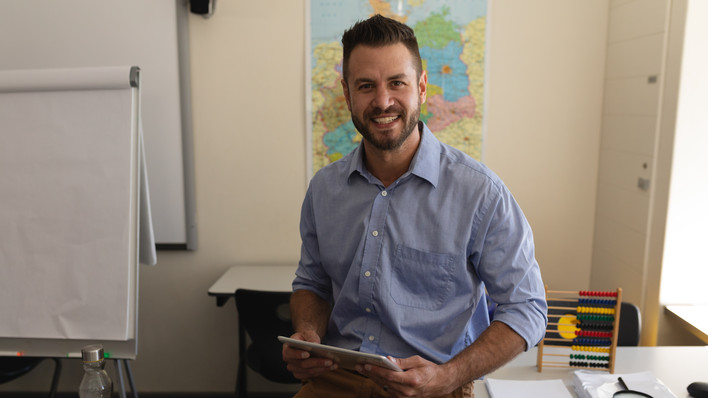The gamification of learning is part of a tectonic shift in higher education — one that emphasizes experiential activities in the classroom and expanded online options to make education available at any point in your career from any corner of the globe.
Northeastern business professor Tucker Marion is building the type of tools needed to make this transformation possible. Two years ago, Marion was recruited by Harvard Business Publishing to create a 30-minute online game that simulates the innovation process. He teamed up with Babson College professor Sebastian Fixson to create a game they launched in August.
The simulation can be played by students either online or in the classroom. The goal is to provide hands-on experience with the innovation process. It’s more than just a gimmick to engage millennials who have grown up on video games and the Internet. It’s specifically designed to expose students to the wide range of innovation methods at their disposal, and the importance of matching the style of innovation to the corporate culture.
“When you develop a game, you want content that’s both experiential and drives home a certain point,” said Marion.
The simulation is designed for use throughout the business curriculum, including courses on innovation, entrepreneurship, operations management, strategic management, product development, and organizational behavior. During the fall semester it was launched at a variety of prestigious institutions including the Massachusetts Institute of Technology, the London School of Economics, and Northeastern.
Last fall, part-time lecturer Lana Caron took the game for a test drive in her in innovation class at Northeastern. The game passed with flying colors.
“It shows students how innovation works in the real world,” said Caron, founder of the Colliston Group, a Boston-based consulting firm. “It allows them to experiment with many different options and how different innovation methods are better suited to different types of innovation and goals.”
The game is set in a medium-sized newspaper that’s struggling with declining subscriptions.
“When you play the game, you’re the innovation manager,” said Marion. “You need to find the best idea while operating within strict cost and time constraints.”
With a $50,000 budget, students have to analyze a variety of innovation strategies, determining which combination is likely to produce the best results given the nature of the task and the company’s tolerance for risk.
For example, would it be more productive to gather lots of ideas inexpensively through crowdsourcing, pay big money for a professional consultant, or focus innovation internally by establishing a bootcamp of company employees? In all, students have 12 innovation options organized into four broad categories.
One advantage of playing the game in the classroom is that teams can be given different mandates from the CEO. For example, one team may be working for a CEO who has a low tolerance for risk, while another is working for a CEO who is less risk-averse and is looking for bold innovations with the potential for producing dramatic changes. The desired result is a lively classroom discussion about how corporate culture influences the direction of innovation.
Business student Adrienne Carr found the exercise illuminating.
“I learned that if the idea doesn’t match the mandate, then it’s not worth testing,” she said. “The CEO made it clear that he wanted a quick win and nothing too crazy. Yet some of the best ideas I received had long implementation times. I made this mistake of ignoring these factors in my first turn and tested a bunch of ideas that didn’t match my mandate. This wasted both time and money. By my third try at the simulation, I ran initiatives that matched my mandate, which was the key to my success.”
Marion emphasized that the game is designed to take a half hour, so there is plenty of time for targeted classroom discussion to help students draw insights from their experiences.
“One of the most important lessons they learn,” said Marion, “is that when it comes to innovation, theres no silver bullet.”
© 2018 Global Data Point. All Rights Reserved. Provided by SyndiGate Media Inc. (Syndigate.info). This article was from Education Monitor Worldwide and was legally licensed through the NewsCred publisher network. Please direct all licensing questions to legal@newscred.com.
![]()



